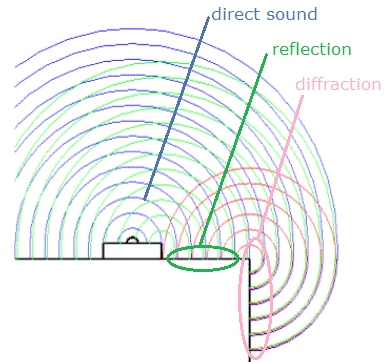DIY Loudspeakers: HOME INDEX UPDATES RESPONSE WHAT'S NEW
Crossovers
Copyright 2024 @ Troels Gravesen
Go to:
Can
you give me advice and/or make me a crossover?
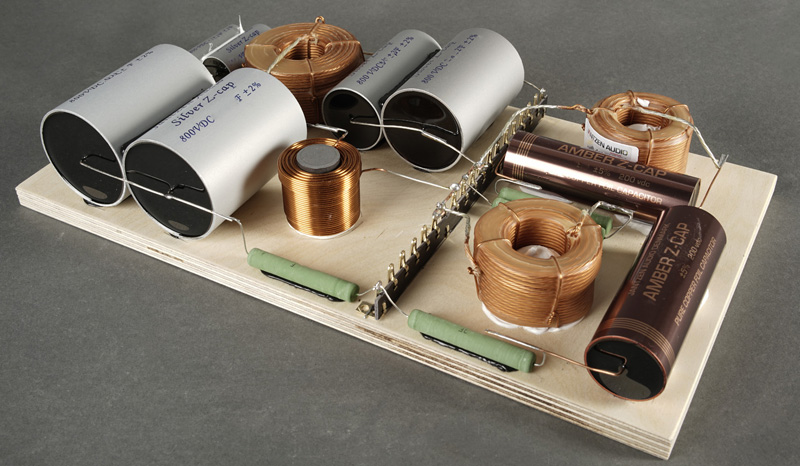
The formulas for calculating crossovers are based on the assumption that drivers have linear response (amplitude), linear impedance and linear phase. NO SUCH THING EXIST.
If you change front panel dimensions, actual drivers, correct impedance, placement of drivers and cabinet tilt in the constructions shown on these pages, you need a new crossover, and I can't help. The crossover will no longer work as intended, so please do not ask because I would need your speakers in my workshop to adjust the crossover, and sorry, I don't do DIY service.
To make crossover we need to measure the
frequency response of the actual drivers on the actual baffle. Due to
reflection and diffraction, the frequency response depends on the actual
driver, the size of the baffle and position of the driver on the baffle, and the crossover must correct for
all this, thus any change = new crossover. Below you can see the frequency
response of the same driver on two different baffles.
I the case of using thicker panels you can increase cabinet depth or
extend the cabinet below the bass driver in an e.g. 2-3-way classic
rectangular front panel.
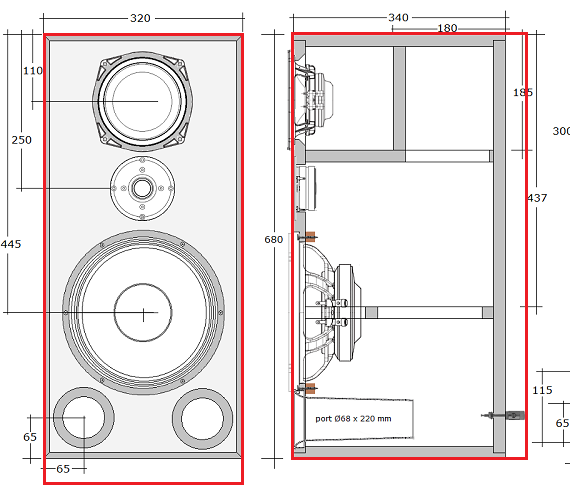
A stepped baffle CANNOT be
replaced by a sloped baffle. The drivers' response will be different =
new crossover.
If you want to use another tweeter, which is the question I
most often have, you need a different crossover. Each tweeter needs its own individual crossover
designed and fine-tuned for its particular response, phase and impedance
for proper integration with the neighboring midrange driver.
Do not fall into the trap of buying a "standard" crossover too often offered by dealers
or on eBay. These crossover are
based on calculation for either 4 Ohms or 8 Ohms drivers and do not take
into account any specific driver or the response of that driver on
your baffle. I have seen horrific results from this.
I have seen dealers providing a full data set, that is frd and zrd data
that allows you to actually use simulation software for crossover
design. Remember, these data were NOT generated on your baffle
and with the drivers in your specific location, so they may be fun to play around
with, but not suitable for making the final crossover for the speaker of
your design. Nor do you have the important
dZ data for proper phase integration.
Sorry, but time doesn't allow assisting in any hypothetical combination of drivers of your own choice, nor renovation of vintage speakers not listed on my website.
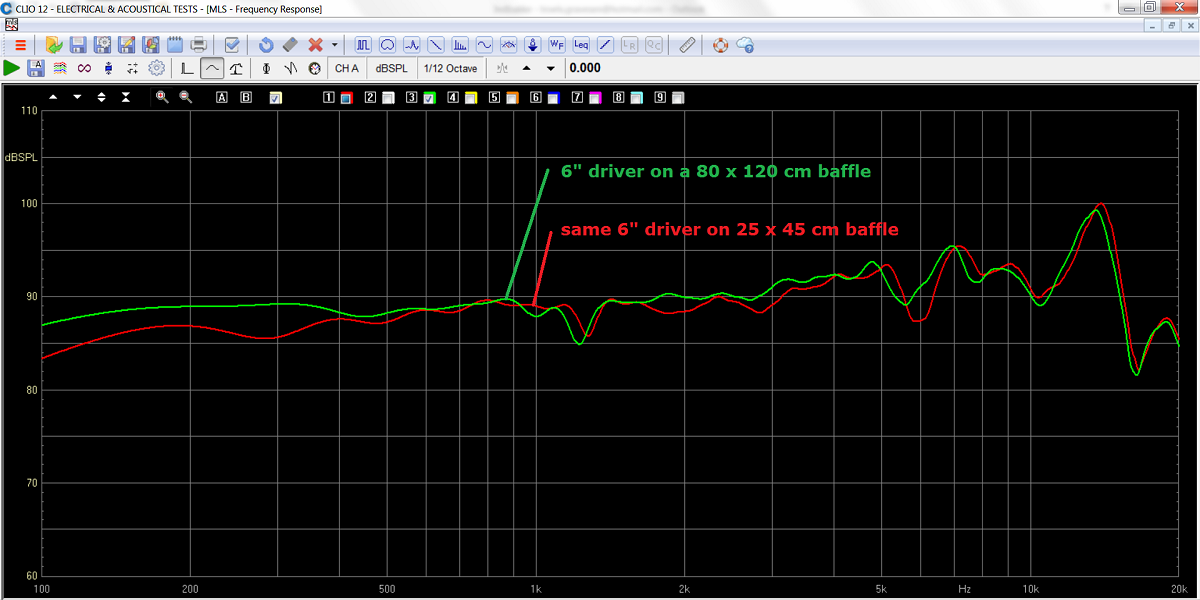
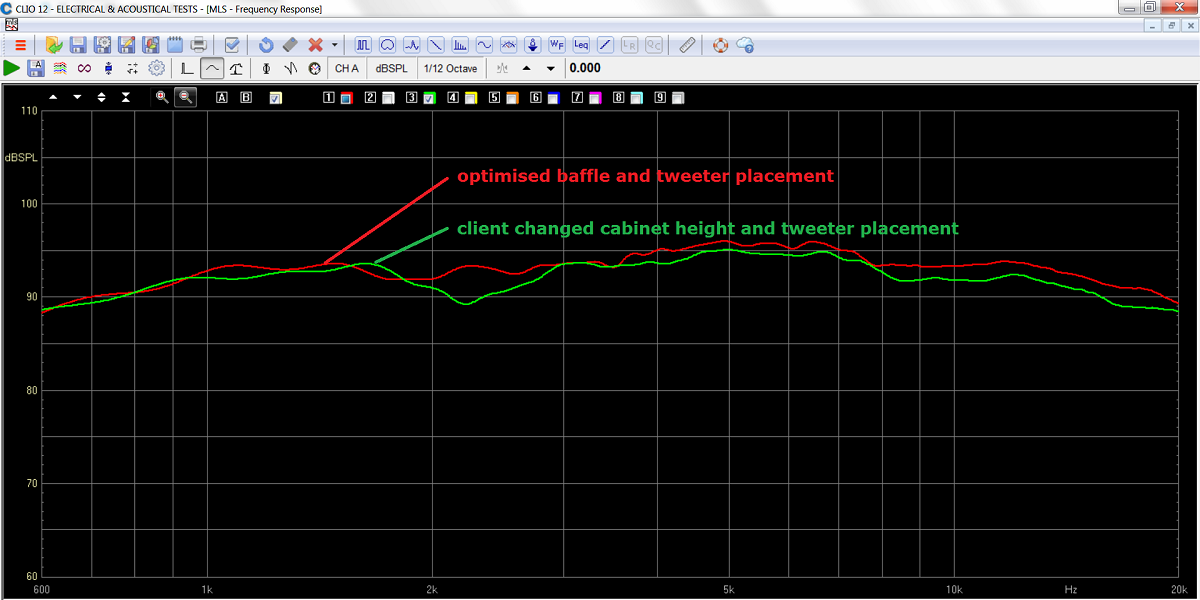
Above the response from ScanSpeak -7140 tweeter on an optimised baffle
(red) and from a client's modified baffle (green). Actually he
only made the cabinet 2.5 cm higher than advised - and he has to live
with a
dip at 2200 Hz. This is as little as it takes!
To get an idea of edge diffraction, watch the
animated presentation
here.
1. Rounding the edges of a cabinet does not
eliminate diffraction.
2.
A very large rounding, large radius, will even out the diffraction
phenomenon.
3.
If driver is placed with the same distance to to top and sides, the
problem can be severe.
Placing the e.g. tweeter with different distance to all nearby edges
will often help to provide a better response, but every driver needs to
be given optimal conditions as far as possible.
4. So, acoustics before design! Form follows function, not the
other way around.
Loudspeakers are a frequent target for designers - and furniture makes - who know little of acoustics and the result is often disastrous, with cabinets providing the worst possible working conditions for loudspeaker drivers and the need for elaborate crossovers to correct for all the problems derived from improper front panels and drivers' placement. Design and acoustics must go hand in hand to make the best of it.
Can you give me advice and/or make me a crossover?
First of all, I don't do DIY-Service work in
case you want advise on what drivers to use in your project, nor help
you making
crossovers, or
advice for
upgrade work on whatever (vintage) speakers you may have. I know it's
sometimes a simple question, but this question most often develop into
extensive mail exchange. Sorry!
Most common mail goes like this: "I have
these and these drivers; can you please make me with a crossover?"
I cannot help you here, because to make a crossover I need to measure
what your drivers do on your cabinet front panel in terms of
frequency
response, phase and impedance. The frequency response will depend on the
dimensions of your front panel and the placement of the drivers. It must
all be measured from your speaker to get it right.
The question is whether we can make a
crossover at all without measurements - and the answer is NO.
It cannot be done, and crossovers cannot be calculated.
We cannot use manufacturers' data sheets to simulate crossovers either, although I know some dealers do so. The frequency response data are most often taken from an "infinite" baffle that does not in any way resemble your cabinet. These data do not contain proper phase data, etc. We also need to measure the actual acoustic distance to drivers from an assumed listening point to get proper phase integration. This simply cannot me calculated, only careful measurements can tell.
Yes, you can set up a speaker with a crossover based on theoretical values that will ensure you won't burn your tweeter or midrange and you may sit back and think this is a great speaker - and maybe it is - but maybe you wouldn't like it if you saw its measuring performance. I have a friend who refuses to let me measure his speakers because he knows he won't like them if he sees how they perform. You may object that this person is perfectly happy with his speakers and so what? And this is perfectly true!
- nothing can compete with "good enough" -
I see a lot of people spending minor fortunes on expensive drivers and "high-end" components and never get the full potential of the drivers due to improper crossovers. The crossover is the heart of the speaker and can be made in numerous ways. Only minor changes to the crossover can turn a great speaker into mediocrity and visa versa.
My best advice is to choose some well documented commercial kits or well documented diy-constructions from the internet if you want to enter the fascinating world of DIY loudspeaker construction. Take great care if you change cabinet construction.
Happy workshop hours!
